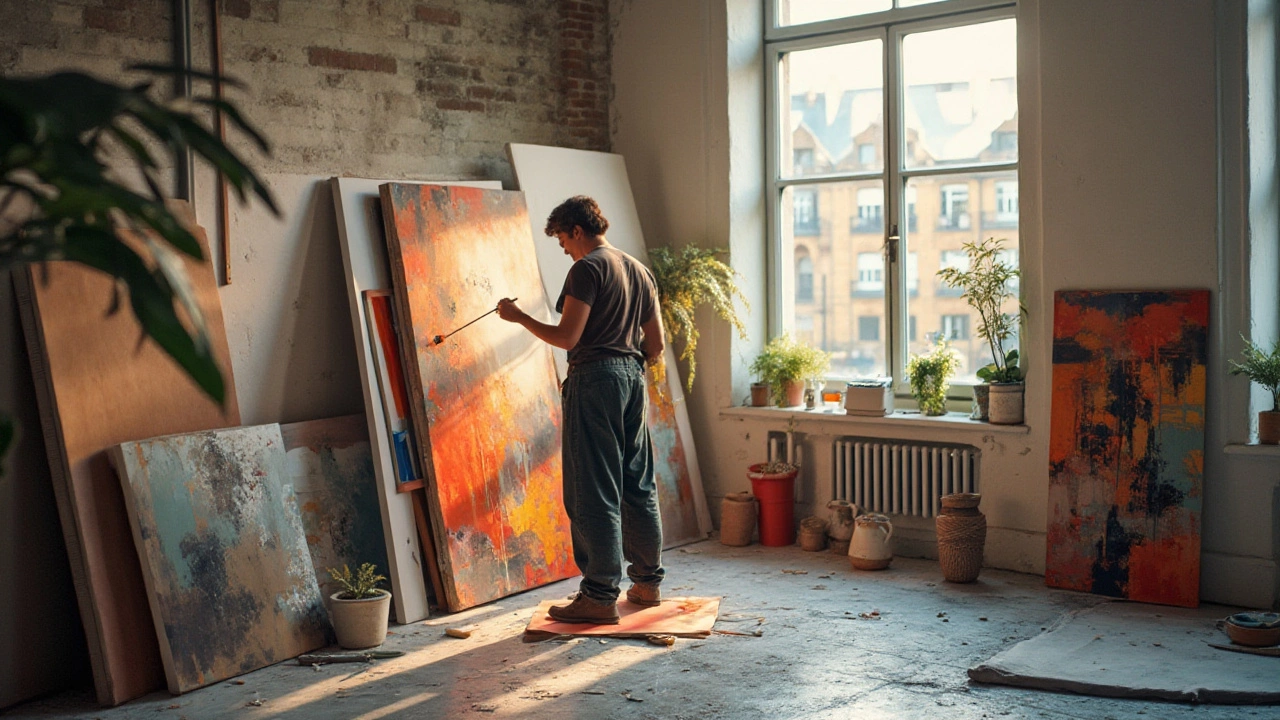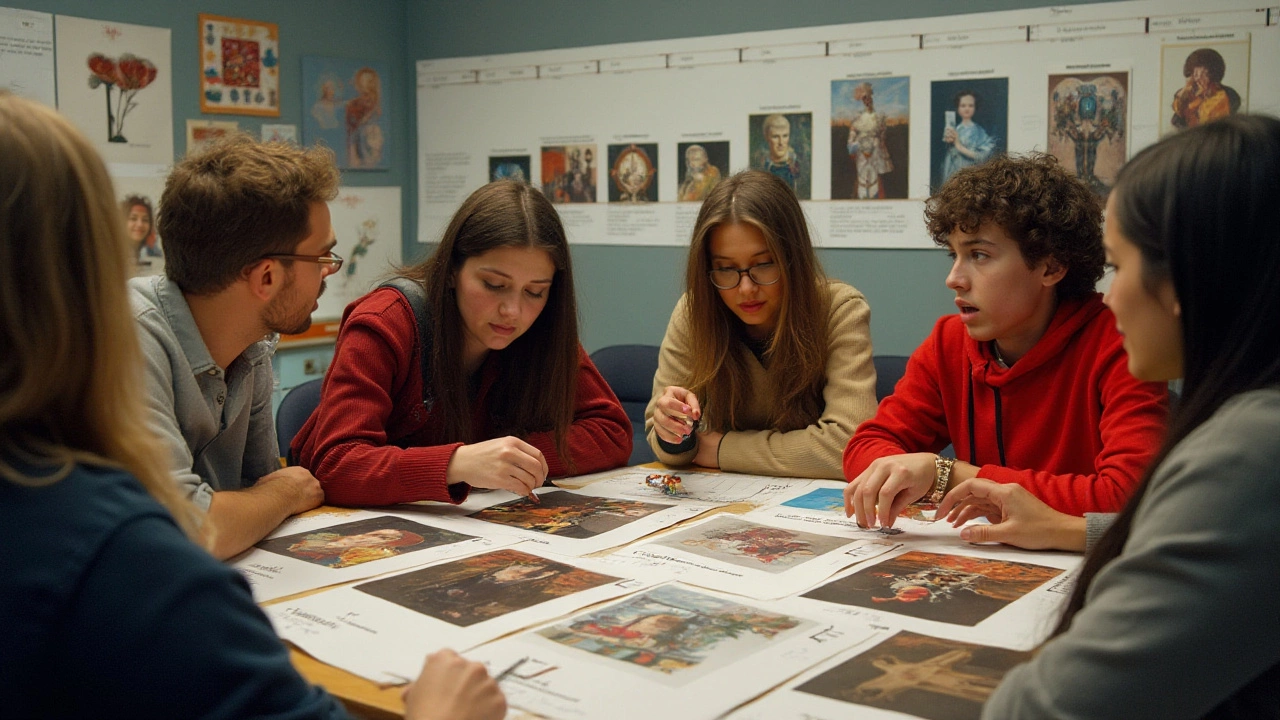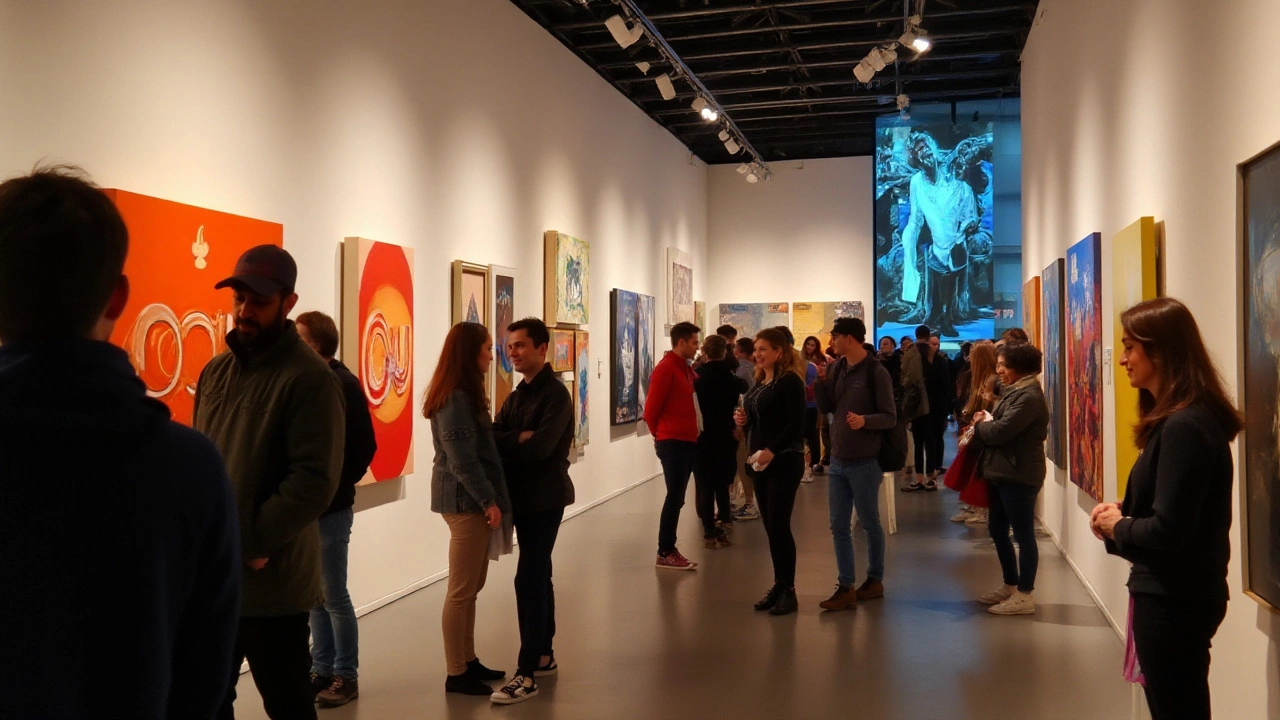The world of modern art is a vibrant, ever-evolving landscape that invites both artists and admirers to explore new perspectives. Unlike the rigid conventions of the past, modern art throws open the doors to endless creativity and individual expression. But what exactly makes a painting modern?
Modern art often prioritizes innovation over tradition, with artists challenging conventional norms through original techniques and concepts. The infusion of technology into art has also played a significant role, opening doors to new mediums and styles. This journey into the realm of modern painting seeks to uncover the intriguing features and cultural shifts that define this captivating genre.
- Defining Modern Art
- Key Characteristics of Modern Paintings
- Impact of Technology and Media
- Notable Movements and Influences
- Modern Art in a Global Context
Defining Modern Art
Modern art is like a rebellious teenager in the world of paintings, often breaking away from the safety of the familiar and diving into the chaos of the unknown. But to truly define what it means for a painting to be modern, we need to stroll through history, noticing when the traditional gave way to the avant-garde. It all began with the late 19th century as artists questioned realism, seeking to represent a more subjective reality. Modern art was born, and it began to reflect the times, absorbing the rapid shifts in culture, technology, and philosophy.
As the 20th century marched on, movements like Impressionism and Expressionism rose up, challenging the status quo with their bold strokes and emotive power. But modern art didn’t stop there. It stretched its limbs further, embracing the abstract, where paintings became playgrounds for shapes and colors, suggesting feelings without the need for form. Such art refuses to be predictable, swaying instead with the artist’s inner world and philosophical musings. This very resistance to categorization is what makes modern art so exhilarating. It invites us, the viewers, to engage, interpret, and connect with our emotional response.
The diversity in modern art can be bewildering, with styles ranging from Cubism and Surrealism to Pop Art and Minimalism. This spectrum showcases how artists are endlessly inspired by their environment and times. In stark contrast to art of previous centuries, which often served religious or political purposes, modern paintings veer towards the personal. They are like intimate confessions of the artist's psyche, marked by an intensity of introspection and, often, commentary on the society that surrounds them. The narratives these paintings embody are fluid, sometimes elusive, yet always engaging in their challenge of the observer’s perceptions.
“Art should comfort the disturbed and disturb the comfortable.” — Banksy
The influence of technology cannot be understated in its role in shaping contemporary painting. A simple brush and canvas are now joined by digital tools that allow for layered complexity and media fusions that were unthinkable just a century ago. With such advancements, modern art continues to evolve dynamically, inviting fresh ideas and perspectives. The blending of new technological mediums doesn’t replace traditional ones but rather enriches them, offering artists a broader palette with which to craft their visions and respond to the world around them.
In defining modern art, it is essential to recognize it as a canvas of endless possibility. It harnesses the power both of tradition and innovation, respecting the past while being unafraid to challenge it. This open-minded nature is why modern art continues to captivate audiences, drawing them into a universe where art and life converge and diverge consistently. Paintings that fall into this category have become more than pictures on walls - they are the beating heart of cultural change, ever reflecting, ever adapting, always inviting us to see a world beyond our own.
Key Characteristics of Modern Paintings
Modern paintings are known for their departure from conventional representation and embrace of innovative ideas. At the heart of these contemporary paintings is a quest to capture complex human emotions and perspectives, often through the lens of experimentation. One of the most distinctive characteristics is the use of non-traditional mediums. Artists like Jackson Pollock and his drip painting technique revolutionized how we perceive art materials. Gone are the days when just paint and canvas sufficed; today, anything from digital technology to found objects can be employed to create a modern art masterpiece.
Another defining trait is abstract expression. Unlike traditional art, where subjects are easily recognizable, abstract modern art embraces ambiguity, encouraging viewers to find their interpretations. This shift allows for a personal connection between the art piece and its observer, a dynamic interaction not always present in past eras. The philosophy here is less about the precise depiction and more about the evocation of a feeling or a thought process. Modern art in this form often leaves room for introspection and dialogue about the human condition.
Color usage also plays a crucial role in distinguishing modern paintings. Vivid and unconventional color palettes are frequently used to invoke strong emotional responses. This was significantly evident in movements like Fauvism, where the emphasis was on bold, vibrant colors rather than realistic portrayals. Such choices engage the audience, drawing them into the painting's narrative while simultaneously freeing them from preconceived notions about color and form.
ITechnology's impact on modern art cannot be overlooked. With the advent of digital tools, artists have new ways to manipulate images, textures, and compositions, leading to previously unimaginable works. Technology also facilitates new platforms for artists to share their work globally. This digital age has allowed modern art to thrive beyond physical boundaries, expanding its reach and influence.
Some of the key art styles that have shaped modern paintings include Cubism, which broke subjects into geometric forms, and Surrealism, which allowed subconscious thoughts to dictate the art. Though different in execution, both styles represent the modern art movement's core willingness to transcend traditional constraints. They encourage viewers to explore deeper meanings and appreciate the intricate layers within each piece.
"Art is not what you see, but what you make others see," remarked renowned artist Edgar Degas. This quote captures the essence of modern art's objective, urging both creators and viewers to look beyond the surface.
To understand modern paintings fully, one must appreciate these defining characteristics that contrast with traditional art's historical roots. By breaking the mold and inviting an array of interpretations, modern paintings have ensured that art continues to be a powerful form of human expression in today's world, constantly evolving with the times and offering new insights into the diversity of human creativity.

Impact of Technology and Media
The evolution of technology has dramatically reshaped many facets of life, and the canvas of modern art is no exception. Today, artists have a glorious palette of tools and mediums at their disposal, thanks to the technological advances that have taken leaps and bounds since the dawn of the internet. Digital art now enjoys a respected place alongside traditional painting methods, enabling creators to explore new dimensions and layers of creativity.
One of the key transformations is the rise of digital platforms, which have democratized art creation and appreciation. Artists can now craft exquisite pieces with software that mimics the brush strokes of renowned painters or pushes them to experiment with animation and interactive elements. The influence of technology isn't just limited to creation but extends to accessibility, as social media platforms offer a global stage that ensures art reaches corners of the world previously inaccessible to many creators. This shift has widened the audience for modern art, making it more inclusive and diverse.
Moreover, with virtual reality and augmented reality technology, the boundaries of experiential art are being tested extensively. Installations and exhibitions that once required physical presence are now accessible online, offering a dynamic, immersive experience from the comfort of one's living room. Artists utilize these capabilities to create multidimensional paintings that envelop viewers in a blend of reality and imagination. Creative art forms like virtual installations blur the lines between traditional and modern art styles, challenging our perceptions of what art means in today's digitally interconnected world.
An important point to note is the role of technology in preservation and restoration. High-resolution imaging and 3D scanning have revolutionized how we conserve masterpieces, ensuring they endure for future generations to enjoy. Interactive AI tools and apps allow patrons to engage with artworks in innovative and instructive ways, further enhancing the educational aspect of art appreciation. Such technological interventions breathe new life into ancient pieces while also cementing the pivotal role of art in cultural heritage.
"I paint with a language that relies on the bright symbolism of modern media," explains celebrated digital artist Petra Cortright, highlighting the bridge between contemporary expression and cutting-edge technology.
The way modern art is bought and sold has also been irrevocably altered by technology. The emergence of online galleries and marketplaces like Artsy and Saatchi Art has changed the traditional art sales model, making it easier for artists to reach buyers without going through traditional gatekeepers. This transformation has empowered artists, offering more freedom to experiment with their works and directly interact with art collectors across the globe. As technology continues to evolve, it will no doubt further redefine the boundaries of creative expression and the role it plays in our dynamic cultural landscape.
Notable Movements and Influences
The story of modern art is richly detailed and layered with numerous movements that have each contributed their own unique flavor to the artistic fabric. At the heart of these movements lies a desire to break away from traditional constraints, pushing the boundaries of what art can be. The roots of modern art are deeply entwined with the upheavals of the late 19th and early 20th centuries. These years saw art movements like Impressionism, which breathed a fresh sense of vibrancy into the art world. Claude Monet and his peers sought to capture the fleeting play of light and color, setting the stage for new ways of seeing and expressing the world around them.
Moving further into the 20th century, the emotional intensity of Expressionism began to take hold, characterized by vivid colors and distorted forms. Artists like Edvard Munch and Wassily Kandinsky used their canvases to convey profound feelings and moods, navigating the complexities of the human psyche. Then came the explosion of Cubism, pioneered by Pablo Picasso and Georges Braque, which shattered perceptual conventions by depicting subjects from multiple angles simultaneously. This radical departure from realistic portrayal inspired many subsequent movements, influencing art across Europe and beyond.
As the century progressed, abstract thinkers like Piet Mondrian and Jackson Pollock redefined beauty in simplicity. Mondrian’s geometric abstractions and Pollock’s dynamic drip paintings opened new paths for creative expression. With each brushstroke, they challenged viewers to look beyond the surface and to find deeper meanings within art’s form and structure. Similarly, Surrealism, led by Salvador Dalí and René Magritte, brought a dreamlike, fantastical quality to art, questioning reality and tapping into the subconscious mind.
The latter half of the 20th century saw the rise of Pop Art and Minimalism, each embodying a reaction to the times. The former, with iconic figures like Andy Warhol and Roy Lichtenstein, celebrated consumer culture and challenged traditional notions of fine art by employing commercial techniques and imagery. Meanwhile, Minimalism, with its reductive aesthetic emphasized by Donald Judd and Agnes Martin, sought purity and order in its simplicity, reducing art to its fundamental components. These movements reflected a world grappling with rapid technological change and mass production, mirrored in art’s embrace of industrial materials and methods.
Art does not exist in a vacuum, and contemporary paintings continue to be shaped by social, political, and technological forces. Today, the influence of digital technology cannot be overstated, as artists integrate virtual reality and artificial intelligence into their works, expanding the realm of possibility and interaction with their audience. The cross-pollination of global cultures has also enriched art styles, creating a tapestry that is both diverse and unified. As art continues to evolve, it captures the essence of its time, a mirror of our ever-changing world.
"Modern art is what happens when an artist is free to choose how to make art, and this freedom has been a defining goal since the early 20th century." – MoMA Learning
From a historical perspective, the journey of contemporary painting through these notable movements reflects humanity's relentless pursuit of expression. Each brushstroke, each daring concept, tells a story of resistance, innovation, and an unyielding quest to capture the essence of existence in new ways. As we look to the future, modern art remains a testament to the enduring power of creativity, forever challenging and inspiring.

Modern Art in a Global Context
Modern art transcends borders, creating a tapestry that reflects a diverse array of cultural influences and contemporary concerns. As artists from around the world break away from traditional confines, they bring to the global stage a mix of techniques and sensibilities, reflective of their unique cultural backgrounds. This amalgamation not only enriches the art world but also challenges the definition of what we consider as 'modern.' Through the proliferation of digital technology and communication, connections among global artists have never been easier or more profound. This results in a shared creative consciousness that sees traditional styles blend with cutting-edge innovations. The global art arena now brims with exhibitions and biennales that celebrate this cultural fusion, offering artists from all corners of the globe a platform to express their visions.
The impact of globalization on modern art is also evident in the rise of collective movements that transcend geographies. Movements such as street art, which began in metropolitan settings, have taken root internationally, with murals surfacing in cities around the world. This is emblematic of how art forms can migrate, evolve, and become part of a broader cultural conversation. Galleries in New York, London, and Tokyo might showcase works by artists from Africa, Asia, or Latin America, highlighting the dialogues and exchanges that are possible within today's interconnected art community. This melting pot of ideas fosters an environment where the boundaries of creative expression are continuously pushed and redefined, ensuring modern art remains as dynamic as the world it mirrors.
"Art enables us to find ourselves and lose ourselves at the same time." — Thomas Merton
A fascinating aspect of the global impact on modern art is the way artists incorporate elements of their heritage while embracing global techniques. Consider the works of contemporary African artists who have gained international acclaim by weaving traditional motifs with digital installations, or Asian artists who reinterpret fabric arts through a modernist lens. Each piece, while distinctly personal, speaks to a global audience and invites a wider appreciation of cultural narratives. The biennales often serve as meeting grounds for such cross-cultural engagements, offering not only exposure but significant inspiration for participating artists.
Statistics in the art market reflect this global expansion, showing a rising demand for contemporary works from emerging regions. A table from Art Basel shows that 2023 saw a 15% increase in buyers from Asia and Africa, illustrating the growing appetite for diverse voices in the contemporary art scene. Such data suggests an exciting trend: the more unique and culturally specific the art is, the more it seems to resonate on a global scale. As artists continue to push boundaries and redefine modern art, the global context in which they operate provides both influence and an audience eager to engage with fresh perspectives. The marriage of the local and the global in modern art promises a future where creativity knows no barriers, inviting us all to explore our world anew through the daring visions of passionate creatives.

